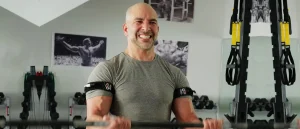Fitness Advice Mark Wahlberg Wishes He Would’ve Listened to 20 Years Ago
Mark Wahlberg’s fitness routine has historically been dictated by movie roles—fluctuating from 212 pounds for Pain & Gain to a lean 137 for The Gambler. But even Father Stu has to take a beat from time to time.
Known for his 4 a.m. workouts, the actor has likely hit the gym, polished off breakfast, and is at the driving range before you have your first cup of coffee. His washboard abs and monstrous quads can attest.
“I’m starting to realize that I’m 51 years old, I need to stay in my lane and know that I don’t have to try to outlift or outwork everybody,” Wahlberg told People. “I just have to push myself a little bit more and continue to drag out this beautiful life as long as I can.” Refreshingly practical words from a man whose abs look rock solid enough to crack an egg on.
Here’s exactly how Wahlberg is shifting his habits—and his mindset— in his fifth decade.
His Workout Routine is Less Intense
In his thirties, Wahlberg’s routine largely revolved around training for his role of Micky in The Fighter—a physique four years (and somedays eight to ten hours) in the making. A typical day involved an eight-mile run, 15 rounds of boxing, heavy strength super sets, and sometimes basketball. In his forties, the actor stayed true to the heavy weights, lifting once at 3:30 in the morning, then hitting a second workout around 4:00 p.m.
“As you get older, you want to be able to move,” Wahlberg told Men’s Health. “Any kind of dynamic movements and exercises have been a game changer for me.” In place of using stationary equipment, Wahlberg subs in unilateral strength moves like lunges and step-ups. He’s also slowing things down to focus on quality over quantity. “I don’t have to lift as heavy, but I have to have better form, a longer hold, and a longer squeeze,” Wahlberg told People.
In combination with intermittent fasting, his more mature approach to fitness allows him to spend less time in the gym while getting better results. “I think because I’m training smarter, I’m getting the rest that I need. I’ll go three days on, one day off,” Wahlberg adds. “I just wish I would’ve listened to the people who were trying to tell me these things and give me this kind of advice 20 years ago.”
While your fitness routine doesn’t have to look entirely different after you hit the big 5-0, like Marky Mark, you may notice a change of pace helps you feel and move better, too. Here’s what to focus on.
Prioritize movement quality
Start every workout with a warmup to prime your muscles for the work ahead. “My workouts start with RAMP, which stands for range of motion, activation, and movement prep—things like Spiderman stretches, hip bridges, and foam rolling,” he told Men’s Journal.
Try joint-friendly exercise variations
Wahlberg’s main work sets involve “bilateral and unilateral strength moves using mostly heavy bands, TRX, dumbbells, and kettlebells,” he told Men’s Journal. Smart move. Heavy, repetitive barbell and machine training work, but, they weren’t designed with joint health in mind. These lifts tend to lock your joint into a set range of motion, making them tricky for those with movement imbalances or pain.
Resistance bands, TRX, dumbbells, and kettlebells, on the other hand, provide a challenging stimulus to your muscles, while allowing freedom of movement. This gives you options to change up the angle to work with the joint range of motion you have.
Do more unilateral moves
Wahlberg is a fan of unilateral exercises—like bent-over rows, Bulgarian split squats, and lunges—which focus on one side of your body at a time. Since most of your life involves moving unilaterally (think: walking, reaching, holding, etc.) training with unilateral movements will help you build functional strength, balance, and stability. Plus, it will help you sus out any strength imbalances, reducing your risk of injuries.
Slow down
Going slow seems like it would be counterintuitive to gaining strength, but Wahlberg is on to something. Particularly, slowing down the eccentric (or the lowering) phase of a lift can help you build even more strength than blowing through each rep. What’s more, longevity experts tout eccentric control for building stability and reducing the risk of falling as you age.











